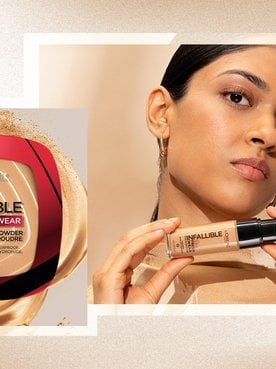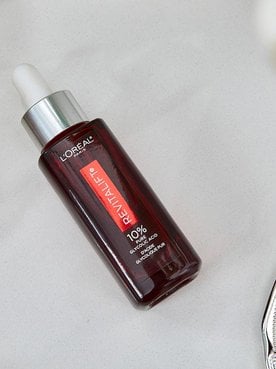If your beauty goals include smoother, more even-looking skin, consider adding alpha-hydroxy acid (AHA) to your routine. This family of ingredients helps address dark spots,fine lines, and rough texture. AHAs have been used in skincare for more than 40 years and appear in many formats. Some products with alpha-hydroxy acids include creams, lotions, serums, and peels.
Incorporating alpha-hydroxy acids is simple once you know the basics. Below, find what alpha-hydroxy acid benefits most, how AHAs work, who they suit, and how to start. We also share our top pick of alpha-hydroxy acid products, so you can easily integrate them into your daily or nightly routine.
Shop the Products
What Is an Alpha-Hydroxy Acid?
Alpha-hydroxy acid refers to a group of organic acids that feature a hydroxyl group on the alpha carbon. They may be naturally derived from milk, fruit, or sugarcane, or synthesized for stability and consistency in modern formulas. In skincare, AHAs provide water‑soluble chemical exfoliation that helps reveal a brighter, more even look.
You will find alpha-hydroxy acids in cleansers, toners, serums, lotions, and creams, as well as in at‑home peels and professional treatments. Choosing the right AHA depends on factors such as molecular size, skin type, and formulation strength. Those factors influence how quickly an AHA exfoliant penetrates and how intensely it acts on skin.
Types of alpha-hydroxy acids
Different AHAs share a similar end goal—smoother, brighter skin—but they behave a bit differently. Use the quick guide below to pick the best alpha-hydroxy acid for your skin concerns.
Glycolic acid
Glycolic acid is among the most studied AHAs used in skincare. It exfoliates to promote a smoother, softer, and more even‑toned complexion. It can also support surface hydration, making it useful for dry or normal skin.
- Best for: Normal to oily skin withdullness, visible pores, or discoloration.
- Concentration: Leave‑on formulas typically range from ~2–10%, and cleansers go up to ~3.5%.
- Caution: Its small molecular size means faster penetration and a higher irritation potential, so start slowly.
Lactic acid
Lactic acid exfoliates like glycolic but tends to feel gentler. It occurs naturally in the skin’s moisture barrier and is often preferred by dry or sensitive types.
- Best for: Dry or sensitive skin, and first‑time AHA skincare users will benefit most.
- Concentration: Leave‑on formulas typically range from ~5–10% in leave‑on care.
- Caution: Monitor for stinging and buffer with moisturizer if needed.
Citric acid
Citric acid, from citrus sources, promotes shedding of dead cells and supports smoother, fresher‑looking skin. It also offers antioxidant support and a brightening effect.
- Best for: Dullness and uneven tone. It complements vitamin C routines.
- Concentration: Typically ~0.5–2% in blends for pH adjustment and brightening.
- Caution: Patch test, especially if you are fragrance‑sensitive.
Malic and tartaric acids
Malic and tartaric are fruit‑derived alpha-hydroxy acids often used in blends. They can smooth, firm, and even the look of skin while offering a milder approach for beginners.
- Best for: Combination skin, AHA beginners, or maintenance between stronger treatments.
- Concentration: Typically ~1–5% in formulas that blend several acids.
- Caution: Watch cumulative exfoliation when layering other acids.
Mandelic acid
Mandelic acid is an alpha-hydroxy acid with a larger molecular size, so it penetrates more slowly and can feel gentler. It is often better tolerated than other AHAs on sensitive or deeper skin tones who are seeking a careful start with acids.
- Best for: Sensitive or reactive skin, and uneven tone on darker skin tones.
- Typical OTC range: Leave‑on formulas typically range from ~5–10%.
- Caution: Introduce gradually and monitor for dryness.
What Do Alpha-Hydroxy Acids Do?
Using an alpha-hydroxy acid for skin can help exfoliate, brighten, and smooth the skin while improving the visible signs of aging—such as fine lines and wrinkles—over time. Keep scrolling to learn more about the benefits of alpha-hydroxy acids.
Help remove dead skin cell buildup
As you age, your skin’s renewal process (known as skin cell turnover) gradually slows. This, in turn, can cause dead skin cells to build up on your skin’s surface, resulting in rough texture, dullness, and flaky skin. Alpha-hydroxy acids can help loosen the bonds that hold dead skin cells together, allowing for gentle exfoliation of surface buildup.
Support skin hydration
Alpha-hydroxy acids are humectants as well as chemical exfoliants. If you need a refresher, humectants are a type of moisturizer that helps attract water to the skin. When used properly, products with hydroxy acids may help keep the skin hydrated, which in turn can promote a more youthful-looking complexion.
Minimize the appearance of fine lines and wrinkles
Alpha-hydroxy acids have long been utilized for their anti-aging benefits, particularly in reducing the appearance of fine lines and wrinkles. A balanced routine with an AHA serum or lotion plus daily sun protection can help give your complexion a smoother, firmer appearance.
Help improve skin texture
By promoting even exfoliation, alpha-hydroxy acids can reduce rough patches and soften flaky areas. Those who do not tolerate physical scrubs may find AHA skincare a more comfortable option. Always pair your hydroxy acids with a gentle, fragrance-free moisturizer, such as theL'Oréal Paris RevitaLift Micro Hyaluronic Acid + Ceramides Line-Plumping Water Cream, to support barrier comfort and hydration.
Promote a brighter, more even‑toned complexion
With consistent use, leave‑on products with alpha-hydroxy acids can brighten dullness and improve the look of dark spots for a more luminous, even tone. Results depend on concentration and your skin’s tolerance, so build up gradually and track how your skin responds. Daily broad‑spectrum SPF, such as theL'Oréal Paris RevitaLift Triple Power Moisturizer with SPF 30, is essential to help preserve brightness and minimize new discoloration.
Support for acne‑prone skin and clogged pores
Alpha-hydroxy acids can help loosen compacted surface cells that can trap oil and debris. If clogged pores are your main concern, pair your alpha-hydroxy acid with a beta-hydroxy acid on alternating days or nights. Avoid layering both every evening to minimize irritation.
Shop the Products
How to Use Alpha-Hydroxy Acids in Your Skincare Routine
If you're curious about alpha-hydroxy acids, choose a format and strength that fits your skin type and goals. Initially, try one to two nights per week, and only increase as your skin remains comfortable.
Start here:
- Pick your format: A cleanser for a gentle start, a toner for light leave‑on exposure, an AHA serum for targeted results, or a peel if you're more advanced.
- Check the strength: Start with lower concentrations for beginners or sensitive skin, and increase within OTC ranges as your skin adjusts.
- Set your cadence: Begin 1–2 nights per week, then build to every other night—or daily—if your skin stays comfortable.
Compatibility and layering:
Layering acids works best with a simple plan. Choose a single strong active per night and build slowly. If you're new to alpha-hydroxy acids, alternate with a hydrating moisturizer before adding other actives.
Use this quick cheat sheet to see how to pair your actives:
- Retinoids: Alternate nights with potent retinoids like the L’Oréal Paris RevitaLift Derm Intensives Night Serum, 0.3% Pure Retinol, especially if your skin is irritation‑prone.
- Vitamin C: Try antioxidants in the morning and acids at night. For example, use the L’Oréal Paris RevitaLift 12% Pure Vitamin C + E + Salicylic Acid Serum in the AM, then your AHA toner or serum in the PM.
- BHAs and other exfoliants: Skip stacking multiple acids in one session. Alternate nights to limit over‑exfoliation.
Remember to do a quick patch test before your first use: Apply a small amount to a discreet area and wait 24 hours. Start with 1–2 nights per week and add nights slowly as your skin stays calm. It's crucial and mandatory that you use sunscreen every morning when using alpha-hydroxy acid products.
Shop the Products
L’Oréal Paris RevitaLift Derm Intensives 3.5% Glycolic Acid Cleanser
If you are new to AHAs, try a gentle cleanser first. This creamy formula with glycolic acid, salicylic acid, and aloe extract removes excess oil and impurities while lightly refining skin. It is non‑drying and suitable for all skin types for morning and night use. This is an approachable entry to AHA skincare.

L’Oréal Paris RevitaLift 10% Pure Glycolic Acid Serum
Target dullness and discoloration with this fragrance‑free 10% glycolic acid serum. It helps refine tone and texture in as little as one week with consistent use and can soften the look of fine lines and dark spots. Beginners or sensitive types can use it two to three times weekly, then build. This focused AHA serum offers visible smoothing in almost no time.

L’Oréal Paris Bright Reveal Dark Spot Exfoliant Peel
This professional‑inspired at‑home peel blends AHAs, BHAs, and PHAs to brighten, minimize the look of large pores, and even tone. Use up to four times per week as tolerated for a more youthful‑looking result. Reserve peel nights for this step alone and skip other exfoliants to avoid over‑processing.

Shop the Products
What Should You Know Before Using Alpha-Hydroxy Acids?
The right alpha-hydroxy acid routine is personal. Use the guidance below to tailor your plan.
Suitability by skin type and tone
Dry or sensitive skin often does best with lower concentrations or gentler options like lactic or mandelic acid. If your skin runs oily, you may tolerate stronger strengths or more frequent use. Deeper skin tones can absolutely use AHAs—just start low, go slow, and watch for signs of over‑exfoliation to help prevent post‑inflammatory hyperpigmentation while keeping alpha-hydroxy acid benefits in mind.
Concentration and pH considerations
Higher concentrations can work faster, but they also raise the chance of irritation. pH matters too, because it changes how active an AHA exfoliant is on your skin. Follow the label and adjust frequency first before moving up to stronger levels.
Sun sensitivity and protection
AHAs can make skin more sensitive to the sun, so daily protection is a must when you use alpha-hydroxy acid. Apply a broad‑spectrum SPF 30 or higher every morning and reapply as directed. When outdoors, seek shade and cover exposed areas during peak hours. Try the L’Oréal Paris RevitaLift Triple Power Moisturizer SPF 30 to keep your skin moisturized and protected.
Over‑exfoliation risks and signs
Common signs include stinging, redness, tightness, dryness, and flaking. If that happens, pause acids and switch to a gentle cleanser and moisturizer. Once things calm down, reintroduce products with alpha-hydroxy acids less frequently.
Who should avoid or use with supervision
Hold off on AHAs if your skin is broken or irritated, during active eczema or rosacea flares, or right after in‑office treatments like lasers or strong peels. If you are pregnant, nursing, or using prescription topicals, check with your clinician first. When in doubt, a quick professional check‑in keeps your routine safe.
Interactions to watch
Be cautious when mixing AHAs with retinoids, benzoyl peroxide, or other exfoliants. Try alternating nights or separating morning and evening routines. Keep it simple as you add a new AHA skincare step.
When to consult a dermatologist
Talk to a dermatologist if you’re unsure about concentration or frequency. Reach out sooner if irritation persists or if you’re juggling concerns like melasma or acne with sensitivity. A professional can help tailor an alpha-hydroxy acid plan and suggest alternatives that fit your skin.
FAQs About Alpha-Hydroxy Acids
What’s the difference between alpha‑hydroxy acids and beta‑hydroxy acids?
AHAs are water‑soluble and work on the skin’s surface, while BHAs like salicylic acid are oil‑soluble and can move through sebum to help with clogged pores. Many routines benefit from one at a time rather than layering nightly.
Can you use alpha‑hydroxy acids every day?
Daily use of alpha-hydroxy acids depends on the specific product and your skin’s tolerance. Start a few times a week and increase if your skin remains comfortable. Then maintain the lowest frequency that keeps results steady.
Is alpha-hydroxy acid the same as retinol?
No, alpha-hydroxy acid is not the same as retinol. AHAs are exfoliants and humectants that work at the surface to remove dead cells. Retinol is a vitamin A derivative that influences turnover and signaling. Most users alternate AHA serum with retinol on different nights to limit irritation.
What are the side effects of alpha-hydroxy acid?
Possible side effects of alpha-hydroxy acid include tingling, redness, dryness, and peeling, as well as increased sun sensitivity. Mitigate by patch testing, reducing frequency, buffering with moisturizer, and using SPF daily.
How long does it take to see results with AHAs?
It may take a few weeks to see results with alpha-hydroxy acids. Texture and radiance can look improved within days to a couple of weeks. Dark spots and fine lines typically require several weeks of consistent AHA skincare, along with diligent sun protection.
Are AHAs safe for darker skin tones?
Yes, alpha-hydroxy acids are safe for darker skin tones with careful use. Start with lactic or mandelic at lower strengths, increase slowly, and prioritize sunscreen to lower the risk of post‑inflammatory hyperpigmentation.
What concentration of aha is safe for at‑home use?
Most OTC leave‑on products range from about 5–10% for AHAs such as lactic or glycolic, while peels for at‑home use provide clear directions for frequency. Follow label guidance and prioritize comfort over speed.
Next Up: 5 Glycolic Acid Benefits for Your Skin That Might Surprise You
Photo courtesy of L’Oréal Paris







